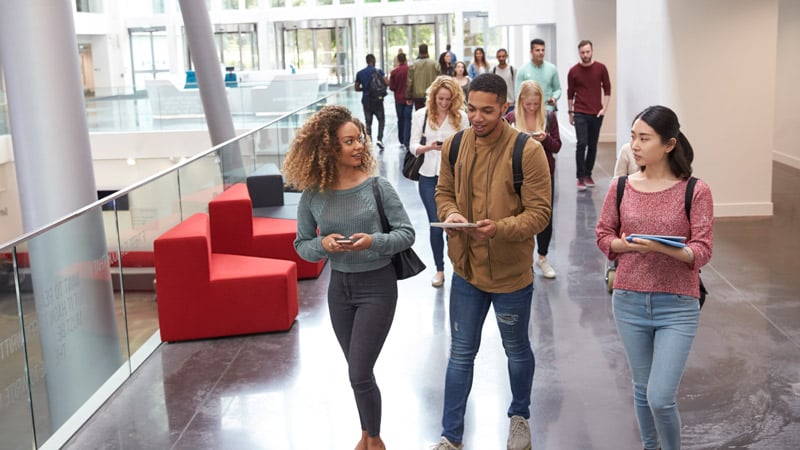Last fall, Vertiv had the opportunity to sit down with CRN to discuss the federal infrastructure funding program known as E-Rate. Feel free to follow along with us as Vertiv Technical Sales Engineer, Ernie Jones, discusses the topic with Katie Bavoso from CRN.
The topics covered in this podcast include defining the E-Rate program, funding for the program, and the opportunity to grow partners’ business by working with Vertiv in the education sector.
KB: Ernie first of all, thank you so much for being here. I’m excited to talk about the E-Rate program, which is something that I didn’t even know too much about before researching for this podcast, so I’m sure our audience is excited about the opportunity there.
E-Rate is also known as the “Schools and Library Program of the Universal Service Fund”. What is E-Rate?
E-Rate: Schools and Library Program of the Universal Service Fund
EJ: Katie, thank you today for letting me get this message out about this important topic of E-Rate. What is E-Rate?
E-Rate is the commonly used term from the Schools and Library Program of Universal Service Fund (USAC). It’s a division of the FCC, and their functionality is to ensure that the funds are distributed to the schools that are most in need.
KB: So why was the E-Rate program started in the first place?
EJ: Well, for those of us that are old enough to remember, back in the day when we had dial-up internet in our house, there was a disparity between the schools. Some school districts had better libraries and access to the internet, and some schools didn’t.
USAC itself was established in 1996, because at that time, only 14% of the nation’s schools had access to the internet. This program was created to cause parity across the education system.
KB: How has the E-Rate program evolved since its start?
EJ: The program itself started off with just running T1 lines into schools, so that schools could have internet. There are so many more things that go with it now. Now we have wireless internet, the kids have tablets, and those systems need to be supported by a strong infrastructure of power by having a UPS and by having monitoring software.
It has evolved from this early stage of just running T1 lines into the school all the way up to where there are actually school buses now with internet on it, so children can do their homework as they ride to school, all funded by the E-Rate program.
KB: It’s amazing it started out with disparate locations for connectivity and now we need a lot of connectivity even on our buses. It’s incredible to think about!
Well, Ernie, that takes us right into topic 2, Funding E-Rate. Question 1 in this topic, how is the E-Rate program funded? Obviously, we know there is a federal connection, but how does that break down?
Funding the E-Rate Program
EJ: Well it’s funded each year through, of course, the federal budget. For schools and libraries, the funds are based on demand, and that demand is determined for each school by how many kids are on the lunch program.
We all recall, and even the kids at school today know, that we (the United States) have the lunch program. Kids who qualify for the lunch program make up the largest percentage of the school. So, if a school today has 90% of the kids on the federally funded lunch program, then that school is entitled to a 90% discount on equipment services they purchase.
KB: Ernie, you talked about this earlier in topic 1, but can you break down what USAC is and what the process is for the education sector?
EJ: USAC is the Universal Service Fund’s program for schools and libraries. It’s an oversight sent down by the FCC to ensure that the funds are being utilized properly for schools. For the education sector, it begins with finding consultants to assist the schools through the process.
The consultants are paid by USAC to assist the schools with the paperwork and get them over that hump. Keep in mind, those consultants are a neutral body and do not assist schools with designing infrastructure or materials. They don’t recommend an OEM. The consultants are just there for one purpose: to assist schools through the cumbersome process of how to get those funds. With consultants, they make it a lot easier.
KB: What is the USAC process for service providers?
EJ: It starts by going to USAC.org, and when you get onto that front page, the first thing you’re going to see is links to E-Rate service providers (health and medical) because USAC is a large governmental body. One of their functions is E-Rate and another function of that is, of course, health infrastructures as well.
By going to USAC.org, you’re going to find the link there; and the first thing it’s going to do is give you a SPIN (Service Provider Identification Number). Once you have a SPIN and your company registered, at that point, it’s just a matter of going after the opportunity.
KB: That brings us to topic 3. Speaking of “opportunity,” we’re now going to talk about Vertiv and E-Rate. What E-Rate eligible products and services does Vertiv offer?
Vertiv & E-Rate: Defining the Opportunity for Partners
EJ: Understanding the USAC process, there are two categories: Category One and Category Two.
- Category One is ‘everything infrastructure’. That’s the T1 line. That’s the fiber. That’s everything running into the school.
- Category Two is the physical equipment itself, including the UPS, PDUs, and racks. What E-Rate eligible products does Vertiv offer? We do that – UPS, racks, PDUs, free software, and even some climate-controlling situations.
KB: What is the advantage of E-Rate for Vertiv Partners? Where is their win here?
EJ: With Vertiv as a partner, you’re not going in alone. You are part of a team. In fact, you’re probably at the bottom 1/3 of the process, which means somebody else is doing that 2/3 for you.
We’re going to find the opportunity. We’re going to define the opportunity. If they’re asking for a competitor’s piece of equipment, we’re going to cross that for you and we’re going to send the information to you. We’re going to give you a great discount on price. We’re going to tell you who you need to contact at the school and here is the bill of material you need to send to that school.
KB: Let’s stay on that thought with helping define the opportunity, how does Vertiv support partners and education institutions through the process?
EJ: We have an entire dedicated team. We have Regional Sales Managers coast-to-coast. We have inside sales folks. We hire a 3rd party outside sales consultant who has developed a “crawler” to go out and find these opportunities and bring them into our team.
A lot of these opportunities will involve “boots on the ground.” You have to walk into the school. You have to take a look at the equipment. We have people across the United States that can do that for or with you; going through the school, take notes, ask those tough questions, and then define the opportunity. Then we present that back to the partner, so they become the trusted advisor to the school.
KB: Thank you so much for your time today and educating me and our audience about this program and the opportunities connected to it that Vertiv supplies.
Become a Vertiv Partner today and start taking advantage of the opportunities that await.
*KB = Katie Bavoso
**EJ = Ernie Jones




